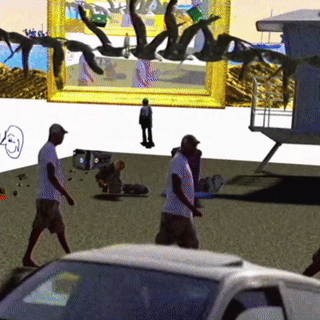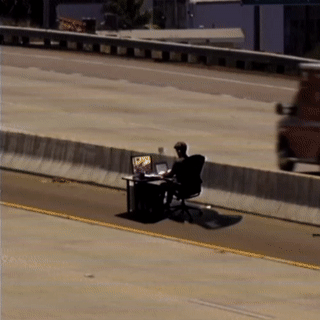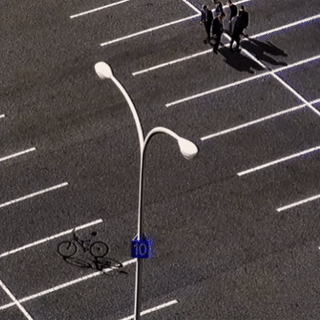THE MOTION ART JOURNAL: THE MUNDANE SURREALISM OF JOE PEASE

MARCH 10TH, 2022
Joe Pease creates surreal loops using video he shoots and acquires using the most straightforward techniques. Cutting things out and layering them together using Photoshop and After Effects. No code, no specially created imagery, just layered motion like a collage artist, but with movement. His material is mundane; parking lots, cars, corporate buildings, bicycles, airplanes. The palette is muted and tends to be the color of concrete. The actions are ordinary. Someone is working at a computer, walking, riding a bike, or falling out of the sky. The last part gives you some idea of how his work can surprise you, as good art should. In my opinion, he has created some of the most perfectly realized loops I have seen.
In some ways, he is similar to the artist Haydiroket who I wrote about recently. While Haydiroket’s work uses similar techniques and has some similarities, the feel is very different to the viewer. Haydiroket’s work is explosive, dynamic, celebratory. Joe Pease puts together imagery of very mundane acts and turns them into beautiful little visual poems of oddness through composition, timing, and editing. It is like the difference between Dali and Magritte. With Dali, it was always obvious what was going on, but with Magritte, you sometimes had to look a few times to see the weirdness of what was going on.
His work $10 a day is an excellent example of this. At first glance, it looks like a bland overhead video of a parking lot with people and cars moving about a bit. But on the second and third viewing, you see the weirdness: A group of men in suits slowly walking in a circle, a car on its side slowly spinning, a man falling out of the sky. You see more things as you watch it, and it never feels tedious. It is so beautifully composed and timed that it is a pleasure to watch. There is no narrative, but things do happen one after the other. It just doesn’t matter which one happens when. Combining the mundane with the weird gives you a feeling that while things may seem ordinary, they never really are. Life is strange, and people are mysterious, despite outward appearances.
$10 a day and his other work remind me of the well-known experimental filmmaker Ernie Gehr. The tools artists had to work with were very different back then, but his use of architecture and his muted palette and compositions feel similar. Ernie Gehr would achieve some of that sense of surrealism by tipping the camera so that people and buildings were at odd angles. A film-like sidewalk shuttle is an example of this. Since loops were impossible back then, filmmakers like Ernie Gehr would make long films with minimal action and no narrative to mimic what a loop does. Another example of this is his most famous film Serene Velocity, a single zoom shot of a corridor cut in a jagged way for 10 minutes.
A great way to see work from this previous generation of experimental motion artists is the website ubuweb which has an incredible collection of experimental artists from the last century.
Joe Pease was kind enough to answer some questions about his work.

The Lot

Controlled Chaos

$10 all day



Where are you located? Do you have a day job?
Living in San Diego I ended up here through happenstance. I freelance for all different companies/artists—everything from motion graphics music videos to whole campaign pieces and documentary style edits.
Where did you grow up? Did you have art training?
I grew up in Australia with an American mother and an Australian father. There was no art training, no real training in general, apart from a few months at a community college.
How did you start making motion art?
I was really into skateboarding as a kid through my older brother. We had a skate video called Mouse from Girl Skateboards. Girl Skateboards is co-owned by Spike Jonze. He would make these skits that played between the skate parts, and I was always drawn to them. They involved everything from stop motion to visual effects. At that time, I didn’t understand how any of that was made or what programs were used. I would make skate edits with my brothers. I constantly experimented with different mediums, from making cardboard cutout stop motion pieces to super basic stuff to illustrations and painting. I always came back to working with motion.
How has your current style evolved? What caused you to work within a specific set of parameters the way you do?
Once I discovered Photoshop/Illustrator and, more specifically, After Effects, my mind opened up to all of the possibilities of how things I had grown up watching were made. At first, I found online tutorials and tried to learn everything about those programs. In the beginning, I based my pieces purely on trial and error. To some extent, this is still how I operate. I always focus on the feeling I want to invoke in the piece rather than be beholden to a process or technique.
Much of my current work evolved from wanting to incorporate a narrative element. I love the idea of seeing one scene from a much larger story and trying to figure out what happened before and what is going to happen next. Constantly trying to chase that feeling I got from watching those Spike Jonze skits and then years after in his music videos. I hope to give people a similar feeling when seeing my work.
What tools/processes do you use to create your work?
Recently it’s a mix of shot footage/photos brought into after effects then manipulated and broken apart. Then depending on the piece, I may need to film people or props to add to the work. Sometimes pieces evolve over several months. I’ll work on something, get it to a certain point, and then leave it. I’ll keep returning to it because there’s something there, but it isn’t quite where I want it, so I keep experimenting and trying different things. The Gardener on SuperRare was a work that evolved over a couple of years.
How long have you been in the NFT scene? How has it gone so far?
Coming up on a year in April. It’s been incredible. It’s been a huge learning curve just figuring the ins and outs. I have been very fortunate to have had a bunch of great artists and collectors who have supported my work and helped push it through their channels. For years my work was just for myself that lived solely on my Instagram. When NFTs came along, I felt so grateful to have a permanent space for my pieces to live.
What artists do you like and follow?
Erik Winkowski, Ben Zank, Alex Prager, Zbigniew Rybczyński, Guy Billout, Radiohead, Michel Gondry, Daniel Crooks
Do you think that Motion Art is a new Art form, as I laid out in my initial piece? Please be honest; some people say ‘no,’ which is fine. I am just interested in the discussion.
I think it is definitely an art form, but not sure I would say it’s necessarily new. People can now look at motion art through a different lens with the help of the blockchain. The blockchain and NFTs changed my outlook on how people can interact with my work.


